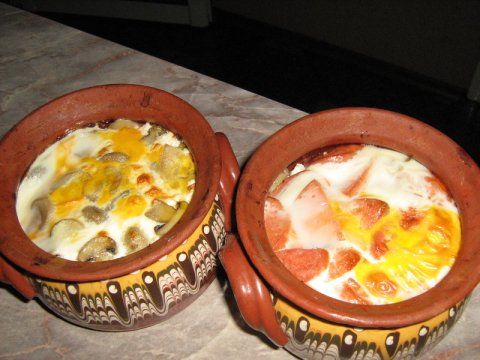Food & Drink
Bulgarian cuisine is heavily influenced by its warm, temperate climate and unique position at a global crossroads, the intersection of European and Middle Eastern traditions.
Fruits & vegetables
 Bulgaria’s yield of fresh fruits and vegetables is varied and delicious. Everything is organic and GMO’s and irradiation are unknown as processing methods. Tomatoes, cucumbers, apples, grapes, peaches, apricots and pears are just some of the many different fruits and vegetables produced in Bulgaria. They’re widely available in farmer’s markets and have contributed to the tradition of eating a salad before every meal. The most notable and widely known such salad is the shopska salad, made of cucumbers, tomatoes and onions and topped with grated sirene (white cheese).
Bulgaria’s yield of fresh fruits and vegetables is varied and delicious. Everything is organic and GMO’s and irradiation are unknown as processing methods. Tomatoes, cucumbers, apples, grapes, peaches, apricots and pears are just some of the many different fruits and vegetables produced in Bulgaria. They’re widely available in farmer’s markets and have contributed to the tradition of eating a salad before every meal. The most notable and widely known such salad is the shopska salad, made of cucumbers, tomatoes and onions and topped with grated sirene (white cheese).
The quintessential Bulgarian salad: shopska.
Dairy products
Bulgaria is one of the oldest regions to produce yoghurt with earliest records dating back to 3000 BCE. There’s even a yoghurt culture named after Bulgaria, Lactobacillus bulgaricus, which is essential to the production of yoghurt. Cow’s, goat’s and sheep’s milk is used not only in yoghurt, but to create the two main varieties of cheese used in Bulgaria: sirene (a white crumbly brined cheese similar to Feta) and kashkaval (a yellow, soft cheese akin to Cheddar).

Yoghurt, sirene and kashkaval
Meats
While beef is not very commonly eaten in Bulgaria, pork, lamb, veal and chicken are all grilled, stewed or turned into sausages. A staple of Bulgaria cuisine is the so called meshana skara or ‘mixed grill”, consisting of several different kinds of sausages and minced meat products. Tripe soup (shkembe chorba) is also widely made, as is a variety of aspic (head cheese) called pacha and a delicious dry sausage called lukanka.
A note for vegans/vegetarians: Bulgarian cuisine relies heavily either on meat or dairy, and while we excel in the wide varieties of salads, eating vegetarian is not tremendously easy.
Pastry
In addition to Balkan staple baklava, Bulgaria is known for banitza: a phyllo pastry marvel made with eggs and sirene. Coupled with airan (a tangy yoghurt drink), it is Bulgarians’ preferred breakfast. At Christmas Bulgarians bake a pita – a round ceremonial bread, often riddled with fortunes wrapped in tin foil, and at Easter a sweeter, flaky bread called kozunak.

Banitza, pita and kozunak
Alcohol
Bulgaria is located in the fertile wine belt of Southern Europe, with several varieties of grape (like Mavrud) native only to its vineyards. Bulgaria has a rich and varied tradition in the production of wine, and also brews decent lagers and pilsners, sold quite inexpensively in 500 ml bottles or on tap and regularly consumed with meals. Bulgaria’s staple drink is undoubtedly rakia: a strong aromatic grape brandy. Ranging in colour from crystal clear to a deep amber, it is sipped chilled before meals and accompanied by a shopska salad or a similar salad of fresh vegetables.
A Sample Bulgarian Meal
Tarator – a cold soup made of yoghurt, water, cucumbers, dill, crushed walnuts and garlic. Lightly salted, it is the perfect cool-off appetizer on a hot evening by the seaside.

Tarator
Shopska salad with rakia – the ice cold rakia goes down in small, burning sips, followed by generous mouthfuls of sun-ripened tomatoes and white cheese.

Shopska salad and rakia
Meshana skara with lyutenitza – the staple mixed grill is flavoured with a traditional condiment made of tomatoes, peppers, eggplant, onion, garlic and black pepper.

Meshana skara and lyutenitsa
Gyuveché – a common name given to diced sausage topped with vegetables, cheese and an egg, covered and baked in a traditional earthenware bowl.

Gyuveche
Borov med – unlike traditional honey (med), which Bulgaria also produces, borov med (literally “pine cone honey”) is made with pine cones picked young, green and still juicy and boiled with sugar to make a honey-like syrup with a unique taste and a dark amber colour. This falls right under “strangest things to make jam out of”.

Young pine cones, ready to be turned into borov med.



Your comment